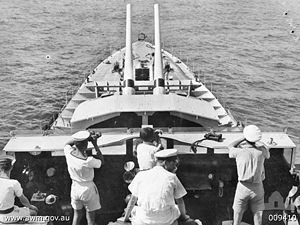QF 4.7-inch naval gun Mk IX, XII
The QF 4.7 inch (120 mm) in the variants Mk IX and Mk XII was a British naval gun . The caliber length was 45 (5.40 m). The specified caliber of 4.7 inches corresponds to 119.4 mm. As with all British guns of this caliber, the exact value was 4.724 inches (120 mm). Both versions used two-part ammunition ( propellant charge and projectile separate).
development
From 1916, the QF 4.7-inch (120-mm) gun was the Royal Navy's standard medium-caliber weapon and was mainly used on destroyers . Its possible use in air defense was limited, however, as there was neither a mount with an elevation range of more than 55 ° nor a corresponding fire control device. In addition, the detonators had to be set by hand. Due to these restrictions and the increasing need for heavier anti-aircraft armament, it was gradually replaced from 1938 by the QF 4.5 inch L / 45 .
variants
The Mk IX was used on most of the Royal Navy destroyers built in the 1930s and 1940s . The version Mk XII was intended for installation in twin towers and was slightly longer and heavier, but essentially identical. In addition, there was a variant of the Mk IX as a deck gun for submarines , but only a few copies were ever used. These were also replaced by the 4 inch / 40 (10.2 cm) QF Mark IV, XII and XXII as the standard weapon for submarines before the Second World War .
A total of 742 Mk. IX and 372 Mk. XII guns of the various types were produced.
Mounts
The open construction of the mounts offered the operating teams little protection against adverse weather, which mainly had an effect on the rate of fire. All single mounts were aligned by hand, the twin mounts were moved by hydraulic pumps.
CPXVI
The mount CPXVI was used for the deck gun on submarines. The elevation range of the manually aligned mount covered the range from –10 ° to + 30 °. During the 1930s all of them were replaced there. Four mounts were converted for use on destroyers and one of them was used on HMS Acasta .
CPXXII
The single mount CPXXII was the most modern mount for the Mk. IX . It featured improvements to the loading mechanism, including a spring-assisted loading ram and a shortened gun return path. These changes made it possible to achieve an elevation range of –10 ° to + 55 °, which, however, was not sufficient for air defense and a rate of fire as with the CPXIX . The carriage was aligned by hand and weighed 11.77 t.
CPXIX
The mount CPXIX was intended for twin mounting of Mk-XII guns. It was the Royal Navy's first motorized carriage specifically designed for use on destroyers. The elevation range covered the range from –10 ° to + 40 ° and therefore use against flight targets was not possible. The weight of a twin tower was 25.5 t. Hydraulic pumps were used as drive, which allowed a recommended speed of 10 ° / s.
use
The QF 4.7 inch replaced the 4.7 inch (12 cm) BL Mark I introduced in the last years of the First World War , compared to which it mainly had an increased rate of fire.
(List incomplete)
Model Mk. IX
- Destroyer classes A to I
- Destroyer class O
- Destroyer classes Q to W
- Submarines Thames , Porpoise , Regent , Regulus , Rover
Model Mk. XII
- Mine layers
- Abdiel class
- destroyer
- Tribal class
- J class
- K class
- N class
- Corrientes class (Argentina)
Web links
- Side Navweapons about Mk IX and XII (English)
